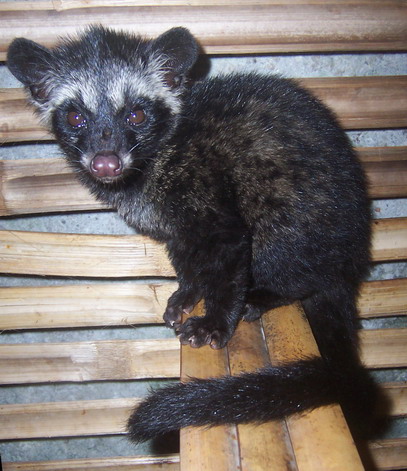| 새로운 사진 | 신문속의 동물소식 | 신기한 동물이야기 | 동물의 소리 | 동물동화상 | 사진 올리기 | 사진 저작권 | English |
|---|
| 재미있는 동물사진 | 괴수/괴어/엽기 동물사진 | 동물이름사전 | 동물목록 | 바깥고리 | 창고입구 | 똑똑누리집 |
|---|
| 이미지 정보 | Original File Name: Paradox_hermaph_060924_ltn-Asian Palm Civet (Paradoxurus hermaphroditus).jpg Resolution: 407x471 File Size: 81030 Bytes Date: 2006:09:24 07:35:53 Camera: KODAK DX6340 ZOOM DIGITAL CAMERA (EASTMAN KODAK COMPANY) F number: f/2.8 Exposure: 1/60 sec Focal Length: 56/10 Upload Time: 2007:10:28 16:18:08 | |
| 올린이 | 이름 (메일주소): Unknown | |
| 사진 제목 | Asian Palm Civet (Paradoxurus hermaphroditus) - Wiki | |
 |
| Email : 카드 | 올린이 | 운영자 사진삭제 정보수정 Admin |
| 설명 | Asian Palm Civet (Paradoxurus hermaphroditus) - Wiki
Asian Palm Civet
The Asian Palm Civet (Paradoxurus hermaphroditus), also known as the Common Palm Civet or the Toddy Cat, is a cat-sized mammal in the family Viverridae native to south-east Asia and southern China. The Asian Palm Civet averages 3.2 kg (7 lb), has a body length of 53 cm (21 in) and a tail length of 48 cm (19 in). Its long, stocky body is covered with coarse, shaggy hair that is usually a greyish color, with black on its feet, ears and muzzle. It has three rows of black markings on its body. The markings on its face resemble a raccoon's. Its tail does not have rings, unlike similar palm civet species. The Asian Palm Civet is a nocturnal omnivore. Ecological, they are frequently compared to as filling a similar niche in Asia that the Common Raccoon fills in North America. Its primary food source is fruit such as chiku, mango, and rambutan. It also has a fondness for palm flower sap which, when fermented, becomes toddy, a sweet liquor. It inhabits forests, parks and suburban gardens with mature fruit trees, fig trees and undisturbed vegetation. Its species name comes from the fact that both sexes have scent glands underneath the tail that resemble testicles. It can spray a noxious secretion from these glands. Its sharp claws allow it to climb trees and house gutters. The SARS virus may have entered the human population from palm civets captured in the wild and improperly prepared for human consumption. In Sri Lanka, the palm civet is known as "Uguduwa" by the Sinhala speaking community. In most parts of the island, Uguduwa becomes a menace to the people due to fact that it litters in ceilings and attics of common households, and then makes loud noises at night disturbing the sleep of the inhabitants of the house (noises are mostly due to their movements and fights). The oil extracted from small pieces of the meat kept in linseed oil in a closed earthen pot and regularly sunned is used indigenously as a cure for scabies. Kopi Luwak is coffee that is prepared using coffee cherries that have been eaten by the animal, partially digested, and harvested from its feces. This species lives in a habitat that is fast diminishing. Subspecies There are a significant number of subspecies of this civet: P. h. balicus P. h. bondar P. h. canescens P. h. canus P. h. cochinensis P. h. dongfangensis P. h. enganus P. h. exitus P. h. hermaphroditus P. h. javanica P. h. kangeanus P. h. laotum P. h. lignicolor P. h. milleri P. h. minor P. h. musanga P. h. nictitans P. h. pallasii P. h. pallens P. h. parvus P. h. philippinensis P. h. pugnax P. h. pulcher P. h. sacer P. h. scindiae P. h. senex P. h. setosus P. h. simplex P. h. sumbanus P. h. vellerosus http://en.wikipedia.org/wiki/Asian_Palm_Civet
| |||
| 댓글 |
| |||||||||||||||||||||||||||||||||||||||||||||||||||||||||||||||||||||||||||||||||||||||||||||||||||||||||||||||||||||||||||||||||||||||||||||||||||||||||||||||||||||||||||||||||||||||||||||||||||||||||||||||||||||||||||||||||||||||||||||||||||||||
| 저작권 정보 | 사진의 저작권은 원저작자에게 있습니다. 동물그림창고는 동물관련 사진을 전시할 수 있는 공간만을 제공합니다.사진을 사용하고자 할 경우에는 저작권자와 협의하시기 바랍니다. |
|
|
|
| |||||||
| CopyLeft © since 1995, 동물그림창고. All rights may be reserved. | ||||||||
Stats